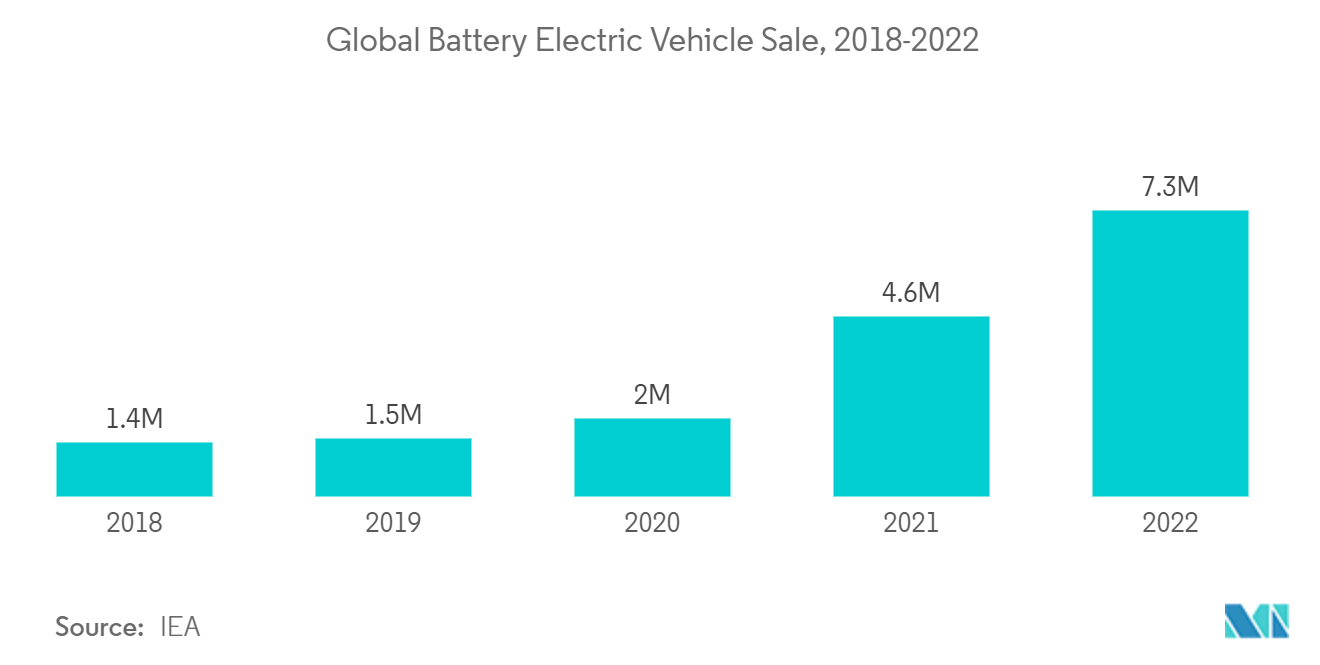Market Trends of Automotive AHSS Industry
Growing Demand for Passenger Cars to Propel the Market Growth
The growing awareness about the benefits offered by AHSS and the rising passenger car fleet are expected to act as primary driving factors for market growth. Furthermore, the growing electric vehicle sales are also pushing the demand for AHSS market growth.
Electric mobility is swiftly growing globally, owing to the fact that transportation companies are also converting their existing fleets into electric propulsion-based vehicles. OEM is redefining its roadmap for electric vehicles. For instance,
In February 2023, General Motors (GM) is coming up with a new EV strategy to push its sales. GM expects to push past the competition with plans to launch seven Ultium-based Evs. Furthermore, the company is focusing on retooling its supply chain for the Bolt EV and EUV in the near future.
Due to the high cost of aluminum as compared to steel, the price of electric vehicles is becoming higher. Therefore, advanced high-strength steels are being used as alternatives due to their stiffness, strength, and ability to absorb energy in the event of a crash. As AHSS has such a high strength, the thickness of the parts can be reduced, helping to bring down the weight. Major vehicle manufacturers use AHSS over conventional steel, which reduces the weight by 25-39%. Such a reduction in vehicle weight helps enhance vehicle fuel efficiency.
Many automobile manufacturing companies are likely to monetize the outpouring of opportunities by gradually including sustainable mobility vehicles in their portfolio. For instance,
In March 2022, Ford Motors announced that it would include three all-electric passenger vehicles in Europe by the end of 2024 and set a target to sell more than 600,000 electric vehicles annually by 2026 in Europe.
In January 2022, General Motors announced that it was considering investing more than USD 4 billion in two Michigan factories to increase its electric car manufacturing capacity.
Governments globally have been proactive in enacting policies to encourage the adoption of electric vehicles. China, India, France, and the United Kingdom have announced plans to completely phase out the petrol and diesel vehicles industry before 2040. By 2040, nearly 54% of the new car sales and 33% of the global car fleets are expected to be electric. Out of it, more than 50% will be battery-electric.

Europe is Expected to Dominate the Market
Europe is projected to dominate the automotive advanced high-strength steel market during the forecast period. Within Europe, Germany is one of the prominent markets for AHSS in automobiles. As one of the largest automotive markets in the world, Germany plays a crucial role in ensuring vehicle safety, performance, and environmental sustainability. Germany's automotive sector is home to some of the world's most renowned automakers like Volkswagen, BMW, and Mercedes-Benz. This naturally translates into a substantial demand for high-strength steel.
The country is the largest steel producer in the EU28, with an annual production of approximately 38.64 billion metric tons of crude steel in 2022. Germany is one of the fastest-growing European countries, even in the electric vehicles market.
According to IEA, in 2022, Germany registered nearly 8.3 million units of electric vehicle (BEV) sales (including battery electric vehicles (BEVs) and plug-in hybrid vehicles (PHEVs)). Future applications of advanced high-strength steel in these electric vehicles are also anticipated to propel the market.
Additionally, due to the existence of major companies like ThyssenKrupp AG, SSAB Group, and Lech-Stahlwerke GmbH, this region is expected to rise towards high growth and high-value segments in the coming years. Additionally, carmakers such as Daimler, Volkswagen, Volvo, Opel, and Toyota are working together to produce more efficient vehicles. Their goal is to reduce energy consumption by 10% and global warming potential (GWP) by 6% by reducing the vehicle’s weight by 31-33% while maintaining the cost. These developments are expected to help the market grow.
Asia-Pacific will remain an extremely attractive market over the forecast period due to the rising automotive production along with green field investments around the region. Following Europe, Asia-Pacific also dominates the significant market share in terms of revenue during the forecast period. An enactment of stringent regulations regarding vehicle fuel efficiency and vehicle safety across the world is likely to boost the market.


